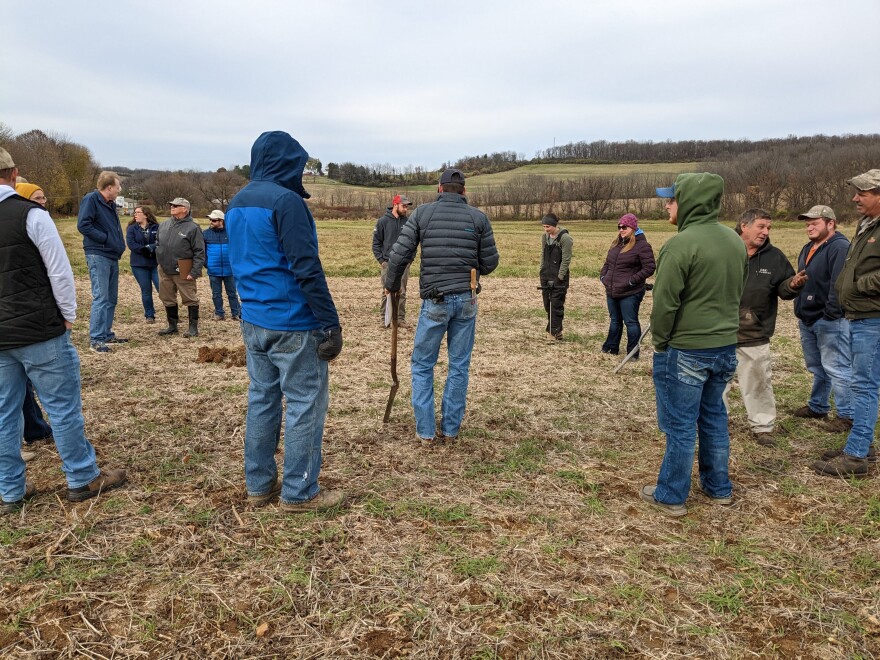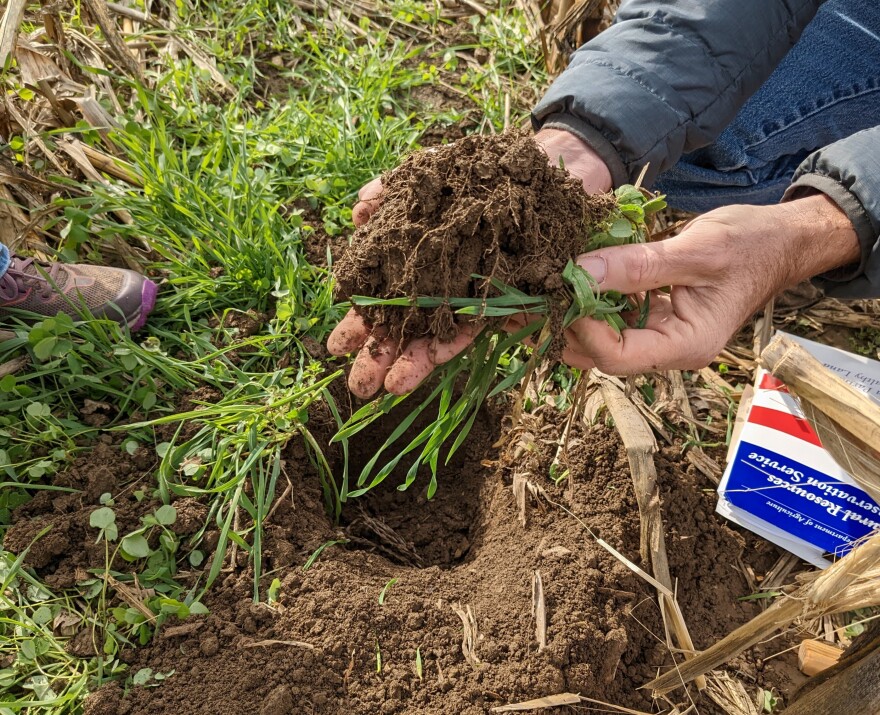UPPER NAZARETH TWP., Pa. – Local farmers say the past year has been particularly difficult for the Lehigh Valley’s agriculture.
On Tuesday about two dozen farmers and ranchers met with experts from the U.S. Department of Agriculture and Northampton County who shared practical advice on ways to improve the long-term health of the soil they work.
- Northampton County hosted a "soil walk" through its Upper Nazareth Township cropland
- A hot, dry July slashed yields for farmers in the Lehigh Valley this year, as prices for fertilizer and other essentials spiked
- With healthier soil, farmers can use less fertilizer
Farmers said this year’s harvest yielded a fraction of the soybeans, corn and other crops it normally would have, thanks to an unusually hot, dry summer.
“Soybean yields are about 50% of what they should have been,” said Joel Geiger, a farmer from Danielsville, Pa.
“We’re probably at about 60% of what we should be,” said Brad Weinhofer, who grows canola, soybeans, corn and other grains on land in Lehigh and Northampton counties.
“Last year, we had a 213 bushel yield average, compared to 53 this year,” farmer Sparky Stein said about his corn crop.
While farmers harvested less, bringing in less money for a season’s work, the price of fertilizer, diesel fuel, herbicides and other inputs spiked following Russia’s invasion of Ukraine. Russia used to be one of the world’s leading exporters of fertilizer, and an important source of the natural gas used to make it elsewhere.
As a result, practices that grow more food with less, or that make crops more resilient, are especially relevant.
In the field
On a cold and windy November morning, ranchers, farmers and agriculture experts walked through corn and soybean fields near Northampton County’s Gracedale complex, led by Austin Drager, the county’s district conservationist with the National Resource Conservation Service, a part of the U.S. Department of Agriculture.
In each field, he stopped to dig a hole, pulling out clumps of dirt to show off the results of the techniques he prescribed to improve its quality.
It looked healthy, he said. Healthier soil needs less fertilizer, copes better with too much or too little rain, resists erosion and ultimately produces more food.
“If we promote the health of that system, that soil biology, it functions at a higher level so we can support a crop with a lot less,” Drager said.
In early September, airplanes flying low over the fields seeded them with clover and rye. Those cover crops and others like them are grown to suppress weeds and control erosion while the field would otherwise be empty between growing seasons.
By Tuesday, only dull brown stubble remained of the harvested corn and soybeans, surrounded by clumps of green rye grass and clover. The plants, along with the no-till management strategy they were a part of, are meant to improve the health of the soil.
“If you notice, it looks similar, but it isn’t the same,” Drager said, examining soil from part of the field that didn’t get any cover crops. “Like it’s not glued together. I’m losing all that benefit of that living root.”
A living soil
It’s easy to think of soil as a collection of minerals, Drager said, an abiotic medium to which nutrients are added by farmers and extracted by growing plants. He said that’s the understanding he inherited from his parents.
“Even through college—the university at the time still had very much this idea that it was just a mineral medium,” he said. “I recently appreciated, over the last 10 years, that it’s not. It’s a living organism. It’s an ecosystem.”

When that ecosystem is in good shape, the soil contains more broken-down organic matter and has a more regular structure. As a result, it is less likely to erode, and can hold more water.
The nutrients already in the soil are more available for crops to use. Communities of beneficial microbes and insects contribute to plant growth. Farmers spend less to grow more.
Making it work
Cover cropping and no-till farming are not new concepts, but the idea is only as effective as its implementation into farmers’ existing yearly plans and crop rotations. Farmers said knowing cover crops are eventually good for the soil, for example, doesn’t matter if there isn’t a window of time to plant them after a harvest, or time to get rid of them before spring planting.
Getting those specifics on implementation was a big part of Tuesday’s events, mostly as farmers asked questions of each other.
“Do you see any nitrogen deficiencies with different stages of growth in your rye? Further on, once it’s more mature, I’m sure you’re going to have more of a deficiency,” Geiger asked fellow farmer Tyler Smith, who works in Northampton County.
“Absolutely. If you’re killing it when it’s three, four inches tall, you’re not going to have too much of an issue,” Smith replied. “But if you let it get really big, you’d better have a hundred units of [nitrogen] on the ground.”
“Would putting a legume in with the rye supply sufficient nitrogen for corn at the beginning, or is chemical [nitrogen] required?” asked Amanda Bunn, the Agriculture Resource Conservationist from Lehigh County.
“I would say it would help. I don’t think it would supply enough,” Smith said. “And, when I’m seeding mine in late September, early October, a legume usually doesn’t fit the mix, unfortunately. I wish it did, but I can’t get enough growth out of a legume at that date.”
“The more that you do no-till and cover cropping, the better your soil is going to get. And it’s hard sometimes to see that in the first three, four, five years.”Tyler Smith, Northampton County farmer
“The more that you do no-till and cover cropping, the better your soil is going to get,” Smith said. “And it’s hard sometimes to see that in the first three, four, five years.”
The process of growing healthier soil can take a decade or more, which might not be as appealing of a prospect for farmers who lease the land they work, as most of them do, often a year at a time.
Plus, any change risks hurting yields.
“When you start dealing more with a soil health system, there's some variables there that you have to rely on the system to provide. And that's a big risk when it's thousands of dollars per acre to grow a crop,” Drager said.
“It’s a business, so you can’t get it wrong too many times before it impacts your bottom line,” he said.


